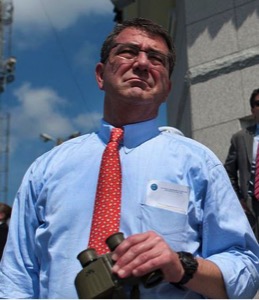
When the issue of trans people is brought up, always just under the surface of discussion is public accommodations in sex segregated facilities such as public locker rooms and restrooms. Without directly discussing it, the majority of us think about bathrooms when discussing anything related to trans people. One recent issue where the public discussion of trans people and public accommodations isn’t directly discussed much is with open trans military service.
During a Q and A with troops in Afghanistan Feb. 22, the new Secretary of Defense Ash Carter was asked by LCDR Jesse Ehrenfeld, “What are your thoughts on transgender service members serving in an austere environment like this here in Kandahar?”
Sec. Carter in his response said, “I don’t think anything but their suitability for service should preclude them [from serving].”
The Military Times reported in their article New SecDef signals support for transgender service, “Lt. Cmdr. Nathan Christensen, a Pentagon spokesman, said there is ‘no specific review of the department’s transgender policy ongoing’ but acknowledged that military health officials began in early February an official reassessment of the current medical accessions policy.
“That policy prohibits military service by people who have a ‘current or history of psychosexual conditions,’’ the article continued, “‘including but not limited to transsexualism, exhibitionism, transvestism, voyeurism and other paraphilias.’”
The current periodic review of the medical accessions policy that Christensen referred to will, according to Christensen, take about 12 to 18 months to complete. According to the Military Times, Christensen emphasized that the review “is not a specific review of the department’s transgender policy.”
Mainstream media isn’t discussing sex segregated facilities yet when discussing trans military service, but it’s there. I see service members discussing the issue of open trans military service on the Military Times’ Web sites, as well as on the online military and veteran discussion forum RallyPoint, almost without exception the comment threads turn to accommodation in the military’s sex segregated facilities.
We can make a reasoned guess what accommodation for trans military personnel would look like by looking at how other federal agencies address trans people’s access to sex segregated facilities.
A Feb. 20 memorandum from the Department of Housing and Urban Development (HUD) entitled Appropriate Placement for Transgender Persons in Single-Sex Emergency 14 Shelters and Other Facilities states, “Best practices suggest that where the provider is uncertain of the client’s sex or gender identity, the provider simply informs the client or potential client that the agency provides shelter based on the gender with which the individual identifies. There generally is no legitimate reason in this context for the provider to request documentation of a person’s sex in order to determine appropriate placement, nor should the provider have any basis to deny access to a single-sex emergency shelter or facility solely because the provider possesses identity documents indicating a sex different than the gender with which the client or potential client identifies. The provider may not ask questions or otherwise seek information or documentation concerning the person’s anatomy or medical history. Nor may the provider consider the client or potential client ineligible for an emergency shelter or other facility because his or her appearance or behavior does not conform to gender stereotype.”
The Department of Labor (DOL) states in DOL Policies on Gender Identity: Rights and Responsibilities “[Office of Personnel Management (OPM)] has interpreted OSHA’s guidelines to support the policy that, for a federal employee who has begun living and working full-time in the gender consistent with the employee’s gender identity, federal agencies should allow that person to use the restrooms and locker room facilities (if provided to other employees) that are consistent with his or her gender identity. Transitioning employees should not be required to undergo, or provide proof of, any particular medical procedure to use facilities designated for use by a particular gender.”
The Trans Progressive column Title IX and schools’ sex segregated facilities spells how the Department of Education (DOE), in its settlements with California school districts, believes trans girls should be treated like girls and trans boys should be treated like boys, and that includes in sex segregated facilities.
When open service for trans people occurs, the military services will likely follow the lead of other federal government agencies regarding sex segregated facilities: likely trans women will be treated as women and trans men will be treated as men.











